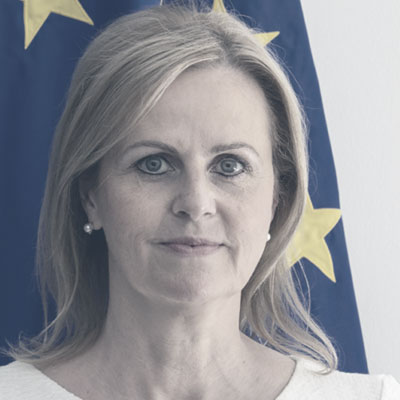
Addressing carbon emissions in supply chains
11th April 2024
Creation of just transition committee among climate action delays
29th April 2024Marcel Haag of the European Commission’s Directorate-General in charge of financial services says that ESG regulation targeting sustainability in the financial sector is key to supporting green policies at an EU level.
 European Union decision-makers are determined to ensure that green and sustainability policies agreed as part of the Green Deal are brought forward and on course toward implementation prior to the European elections in June 2024.
European Union decision-makers are determined to ensure that green and sustainability policies agreed as part of the Green Deal are brought forward and on course toward implementation prior to the European elections in June 2024.
ESG stands for environmental, social, and governance. These are the pillars in ESG frameworks and represent the three main topics that companies are expected to report on. The goal of ESG is to capture the main sustainability-related non-financial risks and opportunities inherent to a company’s day to day activities.
Haag states that the objectives of the EU framework are to align the private sector with the EU’s broad vision for net zero greenhouse gas emissions by 2050, and that the different requirements and tools are designed to help companies finance their transition, rather than forcing them to adopt specific practices.
Broad ESG measures
Under the 2022 Corporate Sustainability Reporting Directive (CSRD), reporting begins in 2025. Haag elaborates that, under the CSRD, sustainability reporting standards “will ensure that companies are transparent about their impact on people and the environment as well as the risks they face from climate change and other sustainability issues”.
Another measure is the EU Green Bond Standard, which Haag explains “aims to support financial market participants in their efforts to align their investment with the climate and the environmental goals”.
On the latest additions to the EU Taxonomy from 2023, he says: “Eligibility reporting by non-financials has started and alignment reporting on turnover, capital expenditure, and operational expenditures, and KPIs will come as of 2025.”
In the area of greenwashing, Haag states that the Commission has asked European supervisory authorities for input on “several aspects relating to greenwashing”.
“We expect the supervisory authorities to provide final reports in the middle of 2024,” he says.
In parallel, regarding biodiversity, the Commission, working also with the OECD, has contracted work toward a methodological supervisory framework for financial risks stemming from biodiversity-related financial losses, to be published “soon”.
Sustainable finance
In the summer of 2023, the Commission issued a comprehensive recommendation detailing how financing for the transition can be undertaken by companies at various stages of sustainability development.
Haag says: “The recommendation provides practical examples and explanations on how companies’ banks, investors, and financial intermediaries can use the taxonomy and other sustainable finance instruments on a voluntary basis.”
The recommendation builds on the four pillars to the Commission’s sustainable finance strategy adopted in July 2021. The first pillar is transition, which means that the EU aims to be “more supportive of intermediate efforts towards sustainability”. Haag elucidates: “We have articulated various options of how the markets can use the existing green taxonomy for transition purposes, which would allow markets to innovate and develop their own instruments and tools such as transition bonds.”
The second pillar is resilience, which involves increasing the ability of banks and insurance companies to manage sustainability-related risks and financial losses resulting from them. “This is key for financial stability and to support the real economy,” he states.
The third pillar is inclusiveness, which is centred on the “need to make sure no one is left behind” in the green transition and that “everyone can fully benefit from sustainable finance opportunities”.
The fourth is about ensuring a global perspective. “For the EU, it is essential to promote interoperability of approaches, provide the private sector with usable tools and metrics such as taxonomies in the EU, but we also want to support developments outside the EU,” he asserts.
Haag points positively to the “encouraging” early signs of the EU’s sustainable finance initiatives. “Many market actors are using the EU framework. Major data providers started reporting green ratios in 2023 based on company disclosures. For example, regarding alignment with the Taxonomy, the average levels are low to begin with, but those who have reported non zero values from among large listed companies reported on average 17 per cent of green revenue, 23 per cent green capital expenditure, and 241 per cent green operational expenditure, mostly in energy, utilities, transport, and manufacturing.”
He adds that the EU’s Sustainable Finance Disclosures Regulation “ensures that financial market participants and advisers disclose all relevant information related to sustainability of their products”, and that “investors can then decide which products to buy”.
In addition to these measures, the European Banking Authority has published a report in December 2023 on green loans and mortgages. Haag states that this is currently being examined by the Commission.
Haag’s broad point is that “regulation for sustainability” is the key to creating green policies at the EU level which are long lasting. This mirrors comments made to agendaNi by Antoine Oger of the Institute for European Environmental Policy, who said that there is a need for green energy policies to be able to survive an anticipated swing to the right in the upcoming European elections.
The results of the European elections remain to be seen, but with opinion polling showing that these electoral prospects may materialise, implementation of long-term green policies will be a top priority for European Commission decision-makers between now and the elections in June 2024.





 Ossian Smyth TD
Ossian Smyth TD Florika Fink-Hooijer
Florika Fink-Hooijer Antoine Oger
Antoine Oger Laura Curtis-Moss
Laura Curtis-Moss Anthony Costello
Anthony Costello Anja Murray
Anja Murray Niall Ó Donnchú
Niall Ó Donnchú Mike Savage
Mike Savage Brian Carroll
Brian Carroll Claire Downey
Claire Downey Oisín Coghlan
Oisín Coghlan Stephen Onakuse
Stephen Onakuse Kevin O’Sullivan
Kevin O’Sullivan Susan Hegarty
Susan Hegarty Hendrik W van der Kamp
Hendrik W van der Kamp Philip Nugent
Philip Nugent Adrian Smyth
Adrian Smyth Ainhoa Gonzalez Del Campo
Ainhoa Gonzalez Del Campo Geoff Doole
Geoff Doole Clare Pillman
Clare Pillman David Greenfield
David Greenfield Danielle Conaghan
Danielle Conaghan Peter McEvoy
Peter McEvoy Triona McGrath
Triona McGrath J Owen Lewis
J Owen Lewis Gavin Smith
Gavin Smith Imelda Hurley
Imelda Hurley Lucy Gaffney
Lucy Gaffney Dr Venkatesh Kannan
Dr Venkatesh Kannan Kevin Hegarty
Kevin Hegarty Eimear Cotter
Eimear Cotter Aditya Arora
Aditya Arora Patric Child
Patric Child Eleanor Roche
Eleanor Roche Andy Bleasdale
Andy Bleasdale Andrew Muir MLA
Andrew Muir MLA Chris Hewitt
Chris Hewitt Francesca Racioppi
Francesca Racioppi Danielle Conaghan
Danielle Conaghan Christopher Hammond
Christopher Hammond Laura Díaz Anadón
Laura Díaz Anadón Lorna McAdoo
Lorna McAdoo Conor Murphy
Conor Murphy Mark Horton
Mark Horton Niall McLoughlin
Niall McLoughlin Zoe Kavanagh
Zoe Kavanagh Niall Ó Donnchú
Niall Ó Donnchú Venkatesh Kannan
Venkatesh Kannan David McGee
David McGee Anna Rose
Anna Rose Paul Hogan
Paul Hogan






















 Levent Ergin
Levent Ergin Veronica Manfredi
Veronica Manfredi Francis Finnerty
Francis Finnerty  Timmy Dooley TD
Timmy Dooley TD  Julie Thompson
Julie Thompson  Mark Thuillier
Mark Thuillier  Martin Hutchings
Martin Hutchings  Mark Nolan
Mark Nolan